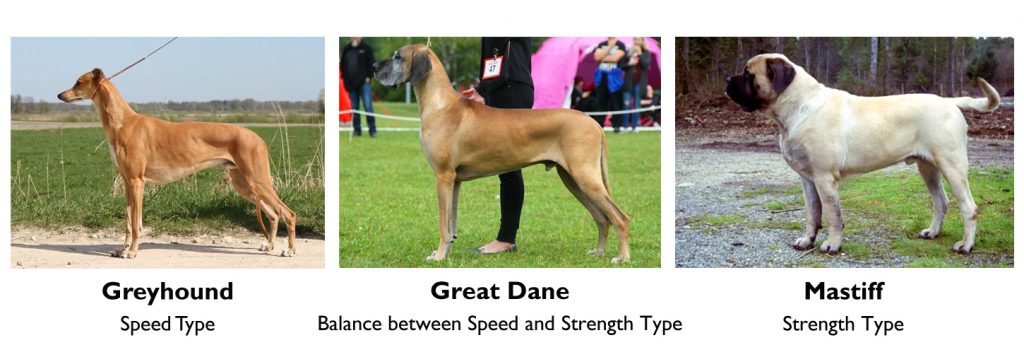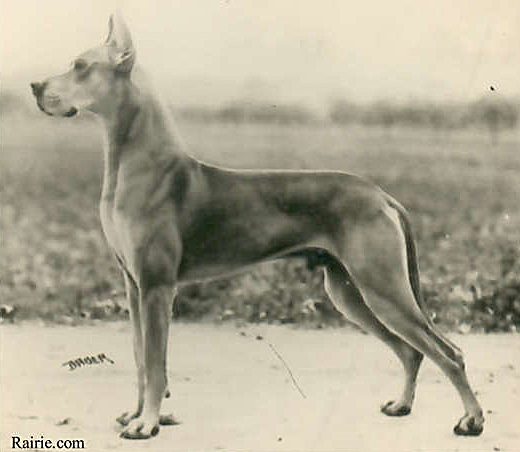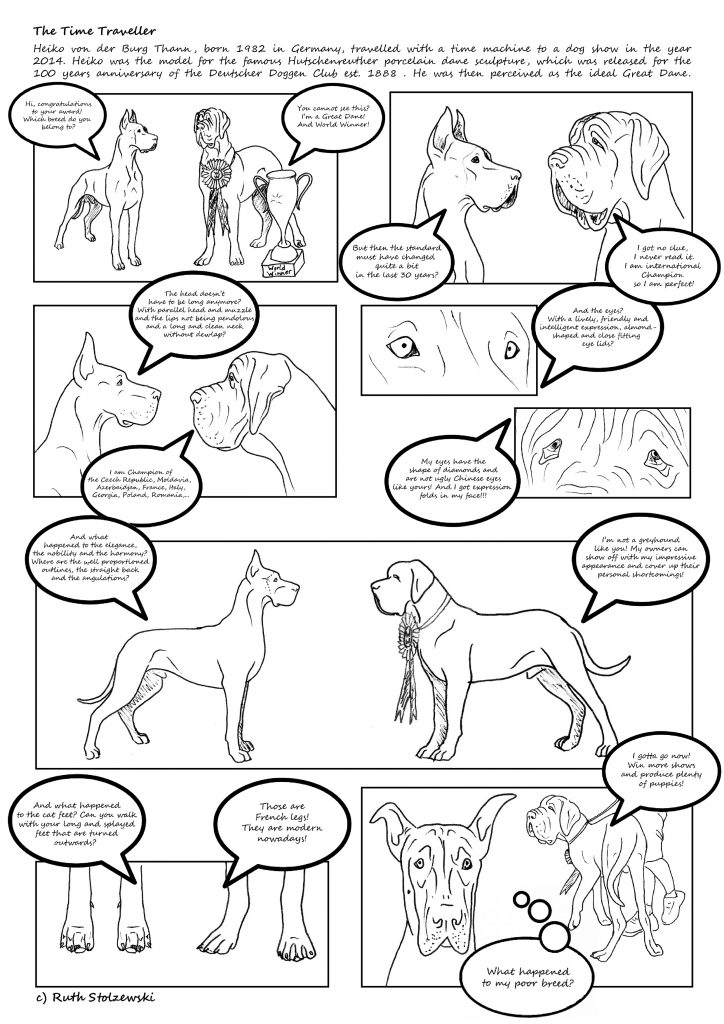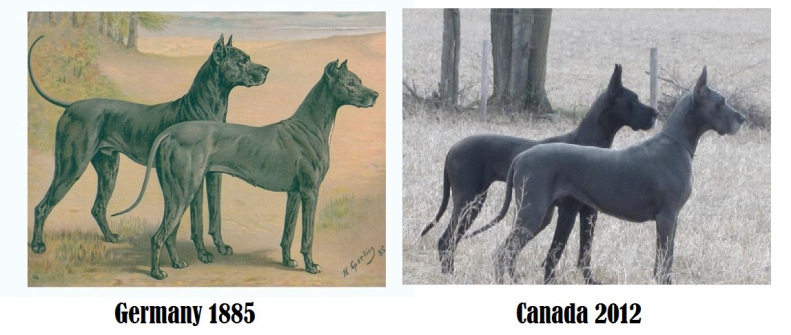The great dane/Deutsche Dogge was created by mixing sighthounds and mastiffs to unite speed with power and to obtain a hunting dog who is fast enough to run after big game like deer, boar or bears and who is strong enough to grab it until the hunter would come and stab it with its lance.
In the first German standard for the great dane from 1880 it is written: “The Great Dane unites in her general appearance size, power and elegance as no other dog breed. She is not so heavy or massive as the mastiff, nor should he too nearly approach the greyhound in type, but keeps the balance between those two extremes.” Also the current FCI-standard NR. 235 for great danes still asks for this balance between speed and powertype. (More about those different motion types of dogs you can find in the book “Dogs in Motion (2016)”)
“As forerunners of the present day Great Dane, one must look at the old “Bullenbeisser” (Bulldog)as well as the « Hatz-and Saurüden » (Hunting and wild boarhounds), which were midway between the strong Mastiff of English type and the fast, handy Greyhound. (…)The Great Dane in his noble appearance combines a large, powerful well constructed body with pride, strength and elegance. By substance together with nobility, harmonious appearance, well proportioned outlines, as well as an especially expressive head, the Great Dane strikes the onlooker as a noble statue, never coarse or with refined elegance.”
FCI-Standard no. 235 for great danes
When firearms were invented and bears and other big game were exterminated the great dane lost its original purpose and became a company dog which guarded the house. But its phenotype could be preserved in the whole world and a homogenous type was bred until the 1980ies.
Also the written standards for the great dane are very similar world wide and didn’t really change in the last 130 years. To keep the balance between two extreme types is a challenge for great dane breeders and slight deviations in one or the other direction cannot be avoided completely. But the breeder should always be focused on the midway between the extremes. But in the last 30 years the appearance of the great dane has been changed on purpose in some parts of continental Europe. The great dane is deliberately changed into a Mastiff/Mastino with long legs!

comparison of the classic type (left) with the hypertype (right). One can easily see the huge amount of loose skin and slobber and the eye problems
This trend has started in France and Italy and spread over the whole of continental Europe, even in the USA those so-called “Euro Danes” are sold for a lot of money by pretending that they are the “original” danes and much healthier than US danes. But in reality those “breeders” ignore the current FCI-standard with the goal to sell their puppies of the “new type” for as much money as possible. Even on dog shows in Europe those dogs – with severe and disqualifying faults like ektropion, dewlap, fluttering lips, a short muszle, a thick and short neck, a round skull etc – are placed first and awarded with Champion titles. Even though many worried great dane breeders and fanciers worldwide take action not a lot has changed about this situation in Europe, as you can see in this video of the World Dog Show in Amsterdam 2018. The “World Winner” in harle was an extreme hypertype male.
Compared to this a Champion from the 1920ies: Bosko von der Saalburg. This dog was considered the ideal great dane back then and shaped the appearance of the breed and helped to unify its look. He was used excessively for breeding (more than 300 offspring) as well as his son Dolf von der Saalburg (more than 500 offspring), which had a negative impact on the genetic diversity of the breed (see: Modern breeding).
Many dog breeds which have lost their original function which has once shaped their form have been transformed into caricatures of themselves by the exaggerated “creativity” of humans. It is the fault of the modern show system, in which not the dog wins which is the closest to the standard but which is the most extreme and eye-catching. And those champions are then often used as stud dogs and the hypertype trend slowly creeps in. This way the whole system of the FCI (International kennel club union) which was created to preserve dog breeds is made a mockery off. To illustrate this absurdity Ruth Stolzewski has drawn a little comic in 2014:
But not only due to aesthetical or historical reasons the hypertype trend has to be stopped. It also has severe consequences for the health of the dogs. Hypertype great danes often have massive eye problems with Ektropion, Entropion etc, huge amounts of loose skin caused by a weak conjunctive tissue which is also under suspicion to increase the risk for a stomach torsion, problem with the skeletal and locomotory system due to an extreme weight etc. So the anyway short lifespan of great danes is even diminished by the hypertype trend and the dogs and their owners suffer.

Eyes: Of medium size with lively friendly intelligent expression. Almond shaped with close fitting lids. Severe faults: Slack eye lids and showing red haw. Disqualifying faults: Ectropion, entropion or macroblepharia.
FCI-Standard no. 235 for great danes
Unfortunately the mother club of the breed in the FCI, the DDC (Deutscher Doggen Club), has not managed to stop this hypertype trend in Continental Europe until today. This is why in 2016 an online petition was started by the Irish great dane breeder and FCI-judge Maria Gkinala with an open letter to the FCI president. More than 3000 people signed the petition. Maria Gkinala is educating about the hypertype problem already for many years in her facebook-group “the Apollo of Dogs” and her Blog “Greatdanegnosis“. Also the American Great Dane Club GDCA has published a letter to the FCI-president in october 2016 asking to preserve the great dane:
Fortunately the great dane is still bred in the original “classic” type according to the written standard in most parts of the world like the USA, Canada, Australia, parts of South America and Asia and Scandinavia. The dogs there still look like the great danes in early years and importing them to continental Europe might help to get back to the original type in those regions. There are also breeders in Continental Europe who stick to the classic type, but they are the minority right now.
Further information about the history and type of the great dane:
Book by Jill Evans „The Time Traveller“: https://www.amazon.com/The-Time-Traveller-Jill-Evans/dp/1491715162
Blog by Maria Gkinala: https://greatdanegnosis.wordpress.com/







